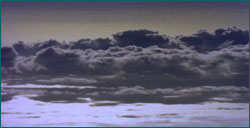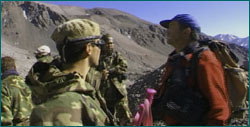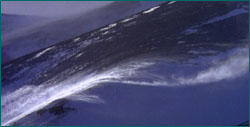 |
 |
|  Clouds can deceive pilots as to what is ground and
what is sky.
Clouds can deceive pilots as to what is ground and
what is sky.
|
Reading the Wreckage
Part 2 | Back to Part 1
NOVA: What sort of wreckage pattern might you expect from a crash in
mountainous territory?
KING: Flying into rock most of the energy is absorbed in destroying the
aircraft, breaking the aircraft into lots of small pieces. That's why finding
crashed aircraft in mountainous terrain can be extremely difficult. There isn't
a big scar across the surface that one finds in open fields.
The wreckage trail can virtually be reversed, in that if the mountain continues
to descend below the point of the impact, the wreckage will tend to fall
backwards in the direction from whence it came, rather than distribute itself
in a forward fashion from the aircraft's momentum.
NOVA: What sort of things would you be looking for to tell you whether or not
there had been a fire either in the air or on the ground?
KING: Fire is one of the enemies of accident investigation in that it consumes
evidence. Major ground fires make interpretation of the scene and wreckage that
much more difficult. Airborne fire has certain characteristics that stand out
from ground fire under some circumstances, so if there has been fire in the air
we do stand a chance of identifying that from examining the detailed fire
signature in the wreckage.
 Members of the
Argentine military team investigate the Stardust crash site.
Members of the
Argentine military team investigate the Stardust crash site.
|
|
NOVA: What advantages do you have now in investigating an accident that you
wouldn't have had 40 or 50 years ago?
KING: First and foremost we have cockpit voice recorders and flight data
recorders, certainly for the major public aircraft types. The cockpit voice
recorder gives us information about what was going on on the flight deck. We
don't have vision, we only have sounds, of course, so there is some
interpretation, but it allows us to tune into crew conversations and
air-traffic exchanges.
The flight data recorder records various parameters about the flight, such as
the height of the aircraft and the speed at which it's traveling against a base
of time. The most modern recorders also look at aircraft systems, giving us
data on how the engines, the hydraulic systems, and the electrical systems are
working. It can tell us an awful lot about what's going on inside the aircraft
mechanically and electrically as well as give us the flight path of the
airplane.
Together these so-called "black boxes"—actually they are typically bright
orange—go a long long way to telling us what has happened. The recording
medium on most is a fairly common recording tape, Mylar tape, which is
encased in a solid outer case to protect it against impact damage. Inside each
box is an insulation material as well to protect the tape against ground fire
for a limited time.
NOVA: What does the data stored in the tapes enable you to do?
KING: After we've downloaded information from the flight data recorder, for
instance, we can present it graphically for people to study and analyze. We can
also create a visualization. We can present the data on a copied instrument
display, that is, in a manner similar to the way the crew would have been able
to observe it, assuming the aircraft's instruments were working properly. We
can also do simulations that enable us to view the aircraft in its maneuvers
from some outside point. What this brings to the analysis is the ability to
make things move in real time. Sometimes when analyzing data on detailed
traces, time is the element that one tends to lose at the speed with which
things are developing.
|  With radio beacons and inertial
navigation systems, flight navigation over the Andes is much safer today than
in 1947.
With radio beacons and inertial
navigation systems, flight navigation over the Andes is much safer today than
in 1947.
|
NOVA: How would you compare navigation today with that of 50 years ago?
KING: Navigating Stardust 50 years ago would have depended on looking
out of the window and using the forecasted winds to predict speed and drift
angles across the ground. In broad terms, aircraft today that are travelling
long distances like Stardust was would be using inertial navigation
systems, which are updated by radio beacons when they're available on the
ground. These systems have multiple redundancies and are very reliable.
NOVA: Can you imagine an aircraft today vanishing for 53 years?
KING: That would be very unlikely to occur today. We have massively improved
communication and navigation capability. It would be extremely unusual these
days for an aircraft to disappear without controllers having an extremely
accurate idea of where it had last been located.
Solve the Mystery of STENDEC |
Mysterious Plane Crashes
Reading the Wreckage |
Inside the Jet Stream |
Resources
Transcript |
Site Map |
Vanished! Home
Editor's Picks |
Previous Sites |
Join Us/E-mail |
TV/Web Schedule
About NOVA |
Teachers |
Site Map |
Shop |
Jobs |
Search |
To print
PBS Online |
NOVA Online |
WGBH
© | Updated January 2001
|
|
|